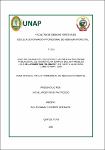| dc.contributor.advisor | Cabudivo Moena, Abrahan | |
| dc.contributor.author | Pereyra Trigoso, Michel Rider | |
| dc.date.accessioned | 2021-03-29T17:05:29Z | |
| dc.date.available | 2021-03-29T17:05:29Z | |
| dc.date.issued | 2019 | |
| dc.identifier.uri | https://hdl.handle.net/20.500.12737/7192 | |
| dc.description.abstract | En el presente estudio se ha identificado, cuantificado y clasificado por sus actividades funcionales a la población de la macro fauna edáfica en parcelas I-III-V del Arboretum “El Huayo” del Centro de Investigación y Enseñanza Forestal Puerto Almendras de la Facultad de Ciencias Forestales de la UNAP con la finalidad de determinar el nivel de la calidad del suelo. La metodología utilizada fue la propuesta por el Programa Internacional Tropical Soil Biology and Fertility (TSBF), que consiste en sustraer monolitos del suelo de 25 x 25 x 30 cm de profundidad que se divide en tres estratos con la ayuda de una pala: hojarasca o mantillo, 0 a 10 cm de profundidad, 10 a 20 cm, y de 20 a 30 cm. obteniendo 5 repeticiones en forma aleatoria por cada parcela.
Los resultados presentan la identificación de 15 órdenes de macrofauna, entre ellos son: Opiliones, aranea, blattodea, orthoptera, himenoptera, isópoda, coleóptera, dermáptera, homoptera, crassiclitellata, hemiptera, collembola, zigontoma, pseudoescorpion y devonobiomorpha. Sobresaliendo las termitas con 1213 ind/m2, seguido de los escarabajos con 768 ind/m2, hormigas con 656 ind/m2 y ciempiés con 560 ind/m2. Referente a las actividades funcionales la parcela III tiene mayor número de población detritívora 720 Ind/m2, mayor población de no detritívoros 1284 Ind/m2, Seguido de la parcela I con 640 ind/m2 de detritívoro y 1168 Ind/m2 de no detritívoro. Mientras que la parcela V presenta 176 ind/m2 de población detritívora y 288 Ind/m2 de población no detritívora, determinándose el índice de 0,56-0,55-0,61 respectivamente, clasificado como nivel de calidad de suelo bajo; por estar ubicado en el rango de índice < 1. | es_PE |
| dc.description.abstract | In the present study we have identified, quantified and classified by their activities functional to the population of the edaphic macro fauna in plots I-III-V of the Arboretum "El Huayo" of the Center for Forestry Research and Teaching Puerto Almendras of the Faculty of Forest Sciences of the UNAP in order to determine the level of soil quality. The methodology used was that proposed by the International Tropical Soil Biology and Fertility Program (TSBF), which consists of subtracting monoliths from the soil 25 x 25 x 30 cm deep that is divided into three strata with the help of a shovel: litter or mulch, 0 to 10 cm deep, 10 to 20 cm, and 20 to 30 cm. obtaining 5 repetitions randomly for each plot.
The results present the identification of 15 orders of macrofauna, among them are: Opiliones, aranea, blattodea, orthoptera, hymenoptera, isopod, coleoptera, dermaptera, homoptera, crassiclitellata, hemiptera, collembola, zigontoma, pseudoscorpion and devonobiomorpha. Termites with 1213 ind / m2, followed by beetles with 768 ind / m2, ants with 656 ind / m2 and centipedes with 560 ind / m2. Regarding the functional activities, plot III has a higher number of detritivore population 720 Ind / m2, a higher population of non-detritivores 1284 Ind / m2, followed by plot I with 640 ind / m2 of detritivore and 1168 Ind / m2 of non-detritivore. While plot V presents 176 ind / m2 of detritivore population and 288 Ind / m2 of non-detritivore population, determining the index of 0.56-0.55-0.61 respectively, classified as a low soil quality level; because it is located in the index range <1. | es_PE |
| dc.format | application/pdf | es_PE |
| dc.language.iso | spa | es_PE |
| dc.publisher | Universidad Nacional de la Amazonía Peruana | es_PE |
| dc.rights | info:eu-repo/semantics/openAccess | es_PE |
| dc.rights.uri | https://creativecommons.org/licenses/by/4.0/ | es_PE |
| dc.subject | Suelo | es_PE |
| dc.subject | Calidad del suelo | es_PE |
| dc.subject | Forma del suelo | es_PE |
| dc.subject | Parcelas | es_PE |
| dc.title | Nivel de calidad del suelo en relación a la diversidad poblacional de macrofauna edáfica en las parcelas I-III-V del Arboretum “El Huayo”, en Puerto Almendra, Loreto-Perú, 2018 | es_PE |
| dc.type | info:eu-repo/semantics/bachelorThesis | es_PE |
| thesis.degree.discipline | Ingeniería Forestal | es_PE |
| thesis.degree.grantor | Universidad Nacional de la Amazonía Peruana. Facultad de Ciencias Forestales | es_PE |
| thesis.degree.name | Ingeniero(a) Forestal | es_PE |
| dc.subject.ocde | http://purl.org/pe-repo/ocde/ford#4.01.02 | es_PE |
| renati.author.dni | 05381376 | |
| renati.advisor.dni | 05205562 | |
| renati.type | http://purl.org/pe-repo/renati/type#tesis | es_PE |
| renati.discipline | 821046 | es_PE |
| renati.level | http://purl.org/pe-repo/renati/level#tituloProfesional | es_PE |
| renati.juror | Álvarez Vásquez, Luis Fernando | |
| renati.juror | Macedo Bardales, Luis Arturo | |
| renati.juror | Urquiza Muñoz, José David | |
| dc.publisher.country | PE | es_PE |


